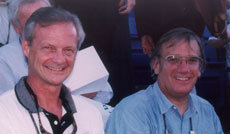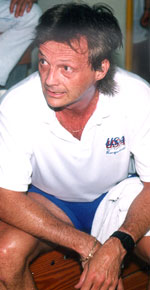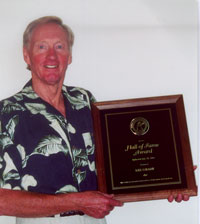
March - April 2002
Vol. 13, No. 2 | Contents
| RB: People |
New Executive Director Named Women's Senior/Masters Activism! Camper's Diary Photo Album: Lee Graff honored |
 Former Associate Executive Director James L. Hiser was recently named Executive Director of the U.S. Racquetball Association by its board of directors. Swift deliberations at the USRA’s 18th annual Leadership Conference in Colorado Springs in early January
led to the board publicly issuing its unanimous decision to conference attendees. Hiser took over the senior position — left vacant by long-time exec Luke St. Onge, who recently stepped aside to accept a directorship of USOC and International Relations for the USRA — in conjunction with the announcement. [L-R
Above: Hiser & St. Onge in Argentina for the 1995 Pan American Games]
Former Associate Executive Director James L. Hiser was recently named Executive Director of the U.S. Racquetball Association by its board of directors. Swift deliberations at the USRA’s 18th annual Leadership Conference in Colorado Springs in early January
led to the board publicly issuing its unanimous decision to conference attendees. Hiser took over the senior position — left vacant by long-time exec Luke St. Onge, who recently stepped aside to accept a directorship of USOC and International Relations for the USRA — in conjunction with the announcement. [L-R
Above: Hiser & St. Onge in Argentina for the 1995 Pan American Games]
Before making the career move to the national governing body for racquetball in 1989, Hiser had earned a Master’s degree from Eastern Michigan University in 1972 and a PhD in Medical Mycology from Michigan State University in 1976. Over the course of those studies, Hiser worked on NASA's Apollo 16 Lunar mission, where he was a member of the first group of scientists to send microorganisms into space. He incorporated the results of that project into his doctoral thesis.
In 1979, Hiser took up the sport and soon thereafter started the successful Michigan "Super 7" racquetball tour. He is also credited with founding the Racquetball Association of Michigan [RAM], the first organization in Michigan affiliated with the then-AARA [American Amateur Racquetball Association]. That became the juncture at which Hiser met Luke St. Onge and the two began a long-term collaboration to develop the sport. In 1988, Hiser accepted an offer to become the Association's Director of Programming and relocated to Colorado Springs in 1989, where he currently resides.
"I left my educational background to work in racquetball because of Luke St. Onge," said Hiser. "I don't think that anyone could have done as much to expand the sport. He has great vision and his passion is unquestionable."
 Hiser's accomplishments within the sport are impressive, both administratively and as an elite level competitor. As an athlete, he is a top competitor in his age division, and earned a silver medal finish at the 2001 National Doubles and a championship title in doubles at the U.S. OPEN championships last fall. As an administrator, he has served as commissioner for both the men's and women's pro tours, was elected to the RAM Hall of Fame in 1985, has coached over 2,500 players privately, through clinics, and at the annual USRA Elite Camp, plus directed over 300 tournaments locally, nationally, and internationally.
Hiser's accomplishments within the sport are impressive, both administratively and as an elite level competitor. As an athlete, he is a top competitor in his age division, and earned a silver medal finish at the 2001 National Doubles and a championship title in doubles at the U.S. OPEN championships last fall. As an administrator, he has served as commissioner for both the men's and women's pro tours, was elected to the RAM Hall of Fame in 1985, has coached over 2,500 players privately, through clinics, and at the annual USRA Elite Camp, plus directed over 300 tournaments locally, nationally, and internationally.
"It's an honor, an exciting challenge, and I look forward to it," Hiser said of taking on his new duties. "I think that I have some new ideas, some different ideas. For the first time we have the racquetball community and industry all working together. I think that it is a good time for us to try and secure an outside sponsorship."
by Kendra Tutsch
Top
After renewing old friendships and perhaps sharing a story or two over drinks, we remembered why we had come to Detroit — to play some great competitive, but fun, racquetball. Round-robin play in all age groups started on Friday morning. The tournament directors, all the volunteers and the staff of the club kept everything going smoothly throughout the weekend. In the larger divisions with flights, seeding for the quarterfinals was determined by flight position and the first round was played late on Saturday afternoon. Semis and finals were played on Sunday morning, so everyone would have time to play and/or watch before heading home. As usual the highlight of the weekend was the Saturday night banquet. Diana and Trish had some special “Motown” events lined up. First we had a contest shooting the puck past a life-size goalie replica, with Red Wings t-shirts as prizes. This was followed by a Karaoke contest ... now we knew the reason for the CD! Most everyone was in a Motown frame of mind by the time the evening was over, and joined Mildred Gwinn in an enthusiastic rendition of “God Bless America.”
Many interesting match-ups occurred on Sunday, starting with the 35+. Last year Kelly Whalen of Wisconsin took first and the year before, her twin sister Kim Whalen had won it. This year, as luck would have it, they both advanced into the final and after each won a game, they decided to call it a draw, peace in the family taking precedence over declaring a winner. In the 40+ bracket, Debbie Tisinger took first as she has each year since 1999, defeating Liz Molitor of Illinois. In the 45+ group Linda Moore of Nebraska, moving up from the 40’s, defeated Susan Pfahler of Florida.
Gerri Stoffregen of Ohio, playing in the 50+ division for the first time, defeated last year’s champion Nancy Kronenfeld of Illinois. In 55+ Margaret Hoff of Illinois defeated Merijean Kelley of California. Newcomer to the 60+ division Sharon Hastings-Welty of Oregon took first over last year’s champion Mildred Gwinn of North Carolina. Other winners were Reta Harring of Wisconsin in 70+ and Helen Deysher of Pennsylvania in 80+. In a show of perseverance, Helen had traveled for more than 15 hours by bus and train to reach Detroit for the tournament! All winners received a fantastic trophy in the shape of a gold, silver, or bronze record and a certificate for a pair of Ektelon shoes.
Next year this Level Five tournament (and regional qualifier for 45+) will be held at the Orlando Fitness and Racquet Club in Orlando, Florida on January 17-19. If you want fun, friendship and the best racquetball competition, plan to attend! For more information or to join the Women’s Senior/Masters Racquetball Association, contact Kendra Tutsch, 7562 Fellows Road, Lodi, WI 53555, (608/592-2497) or send e-mail to kdtutsch@facstaff.wisc.edu.
2002 Women’s Senior/Master Final Results
35+: Kelly Whalen (WI) & Kim Whalen (WI)
40+: Debra Tisinger (CA) def. Liz Molitor (IL)
45+: Linda Moore (NE) def. Susan Pfahler (FL)
50+: Gerri Stoffregen (OH) def. Nancy Kronenfeld (IL)
55+: Margaret Hoff (IL) def. Merijean Kelley (IL)
60+: Sharon Hastings-Welty (OR) def. Mildred Gwinn (NC)
70+: Reta Harring (WI)
80+: Helen Dysher (PA)
by Dick Barton
Top
The Park Ridge Community Center was built about 10 years ago with only three racquetball courts. Over the years, the courts started being used for Wallyball – a version of volleyball played in a court. This was generally okay with the local racquetball players. Share and share alike.
Then, last summer the Park District that owns and manages the Center started scheduling regular classes in the courts. These classes were mostly for various low impact types of workouts such as stretching. But, as time went on, additional non-racquetball activities were scheduled in the courts. These activities included blood drives, photo sessions for youth basketball and softball, and heaven knows what else.
The local racquetball players didn’t like it but still no one complained. No one wanted to “make waves.” ... [excerpt]
1. Read the material on the USRA website. This will give you a good perspective on the problem and give you some information to share with your local club owner, park district, or other facility management. Show them that racquetball courts are profitable when used properly.
2. Organize the players in your area. Do this by collecting names from leagues, lists from tournaments, or from your state racquetball association. Contact fellow players to discuss the problem in your area and ask for their support and assistance.
3. Organize a formal meeting between the club owner/manager and a small group of players. Voice your complaints and offer solutions such as ways to increase the use of the courts with youth instructional classes or tournaments. Volunteer to help organize these new events and generate interest in the facility and its racquetball courts.
4. If you are dealing with a tax-supported entity such as a city, park district, county or whatever, don’t be afraid to take your case to the news media. Call or visit your local newspaper editor to explain the problem. Show them as many relevant facts that make sense and ask that the newspaper run a story or do an editorial. Elected officials HATE bad publicity.
5. And, if all else fails to get action then take a clue from the famous 1960’s and protest, baby, protest! Stage a sit-in. March in front of the facility with signs. Make angry phone calls and send letters to all the elected officials involved, the news media, and anyone who can help change things. Make something happen!
by Christy Cramer and Sharon Dunn
Top
 Want to improve your racquetball game quickly and have fun doing it? Put a racquetball camp on your calendar now! We both love the game but had hit a plateau and didn’t have a good plan for breaking through. We play singles, doubles and mixed doubles and were frustrated by the minimal progress we were making…we had tried all the usual things; different racquets, gloves, vitamins etc. And of course our playing friends all gave us advice (often contradictory). Then one day after a particularly frustrating match we agreed that we needed HELP!
Want to improve your racquetball game quickly and have fun doing it? Put a racquetball camp on your calendar now! We both love the game but had hit a plateau and didn’t have a good plan for breaking through. We play singles, doubles and mixed doubles and were frustrated by the minimal progress we were making…we had tried all the usual things; different racquets, gloves, vitamins etc. And of course our playing friends all gave us advice (often contradictory). Then one day after a particularly frustrating match we agreed that we needed HELP! We had both read Marcy Lynch’s article The Comfort Zone in the January-February 2001 issue of Racquetball magazine. Marcy wrote that many of us feel that “improvement is not only exciting, it is what keeps us interested in the game. There is no limit to learning. As long as we are willing to question, there will be ANSWERS and ways to improve”. The opposite page featured a Fran Davis Q&A session and a flyer promoting an upcoming three day racquetball camp in Houston. Our husbands were very supportive and off we went to racquetball camp. [Off the record, Sharon’s husband Brian says he doesn’t mind her racquetball travels now and then because he then “can have the TV remote.”] ... [excerpt]
Top
 Lee Graff of Bend, Oregon became the 26th member to be inducted into the National Masters Racquetball Association Hall of Fame. He was honored at the NMRA International Championships in July at the Wisconsin Athletic Club in Milwaukee, Wisconsin.
Lee Graff of Bend, Oregon became the 26th member to be inducted into the National Masters Racquetball Association Hall of Fame. He was honored at the NMRA International Championships in July at the Wisconsin Athletic Club in Milwaukee, Wisconsin.Graff began playing racquetball in 1985 and earned his first medal in NMRA competition in 1993 – a pewter medal in men’s 55+ singles. Since they he has totaled 37 medals, including 13 gold and 10 silver, in both singles and doubles competition. In 1999 Graff was also featured in Sports Illustrated’s “Faces in the Crowd” for what he calls “winning the ‘Big Three’ in a row.” That is the U.S. OPEN, NMRA Singles, and the USRA National Singles championships – all in the 60+ division.
The NMRA is an organization of men and women racquetball players and supporters over the age of 45. Over 1,000 members worldwide are active members of the NMRA. It was started in 1971, when ten players gathered in New Castle, Pennsylvania and held what is believed to be the first tournament solely for age group participants.
Top | Racquetball Online | USRA
© United States Racquetball Association
All Rights Reserved